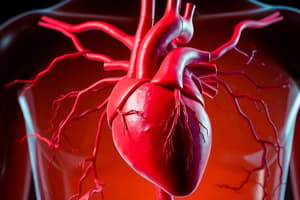Podcast
Questions and Answers
What is the main function of the circulatory system?
What is the main function of the circulatory system?
- Transport of gases and waste products
- Regulation of body temperature by controlling blood flow to the skin
- Defense mechanism by transporting leukocytes and antibodies
- All of the above (correct)
Which division of the circulatory system involves the flow of blood from the left ventricle to the aorta, large arteries, arterioles, and capillaries?
Which division of the circulatory system involves the flow of blood from the left ventricle to the aorta, large arteries, arterioles, and capillaries?
- Coronary circulation
- Peripheral circulation
- Systemic circulation (correct)
- Pulmonary circulation
What is the function of pulmonary circulation?
What is the function of pulmonary circulation?
- Regulation of body temperature
- Gas exchange (correct)
- Transport of nutrients to the tissues
- Defense mechanism against infections
Where does the blood flow in pulmonary circulation?
Where does the blood flow in pulmonary circulation?
What does the transport function of the circulatory system include?
What does the transport function of the circulatory system include?
How does the circulatory system contribute to maintaining homeostasis?
How does the circulatory system contribute to maintaining homeostasis?
What is the function of the atrial muscles?
What is the function of the atrial muscles?
Which valve separates the right atrium from the right ventricle?
Which valve separates the right atrium from the right ventricle?
What is the main function of the semilunar valves?
What is the main function of the semilunar valves?
What is the absolute refractory period (A.R.P) of the cardiac muscle?
What is the absolute refractory period (A.R.P) of the cardiac muscle?
Which chamber of the heart receives blood from the body through superior and inferior vena cava?
Which chamber of the heart receives blood from the body through superior and inferior vena cava?
What is excitability in relation to cardiac muscle?
What is excitability in relation to cardiac muscle?
What is the left ventricle's wall thickness compared to the right?
What is the left ventricle's wall thickness compared to the right?
When does mechanical contraction of cardiac muscle start?
When does mechanical contraction of cardiac muscle start?
What is the function of the tricuspid valve in the heart?
What is the function of the tricuspid valve in the heart?
During which phase of the cardiac cycle does mechanical contraction (systole) of the cardiac muscle start?
During which phase of the cardiac cycle does mechanical contraction (systole) of the cardiac muscle start?
What happens during the relative refractory period (RRP) of the cardiac muscle?
What happens during the relative refractory period (RRP) of the cardiac muscle?
What is the main function of the circulatory system?
What is the main function of the circulatory system?
Which chamber of the heart pumps blood to the aorta to reach different organs of the body?
Which chamber of the heart pumps blood to the aorta to reach different organs of the body?
What is the relation between mechanical response and action potential in the cardiac muscle?
What is the relation between mechanical response and action potential in the cardiac muscle?
During which phase of the cardiac cycle does the supernormal phase of excitability coincide?
During which phase of the cardiac cycle does the supernormal phase of excitability coincide?
Which fibers are responsible for conducting the electrical signal generated by the sinoatrial node (SAN)?
Which fibers are responsible for conducting the electrical signal generated by the sinoatrial node (SAN)?
What is the speed of transmission in the atrioventricular node (A.V. N)?
What is the speed of transmission in the atrioventricular node (A.V. N)?
What is the physiological importance of the atrioventricular nodal delay?
What is the physiological importance of the atrioventricular nodal delay?
Which factor directly affects the force of myocardial contraction according to Starling's Law?
Which factor directly affects the force of myocardial contraction according to Starling's Law?
What is the period during which the ventricles contract and force blood out into the aorta and main pulmonary artery called?
What is the period during which the ventricles contract and force blood out into the aorta and main pulmonary artery called?
What is the volume of blood pumped by each ventricle per minute known as?
What is the volume of blood pumped by each ventricle per minute known as?
What is the function of xanthines like caffeine and theophylline?
What is the function of xanthines like caffeine and theophylline?
Flashcards are hidden until you start studying




